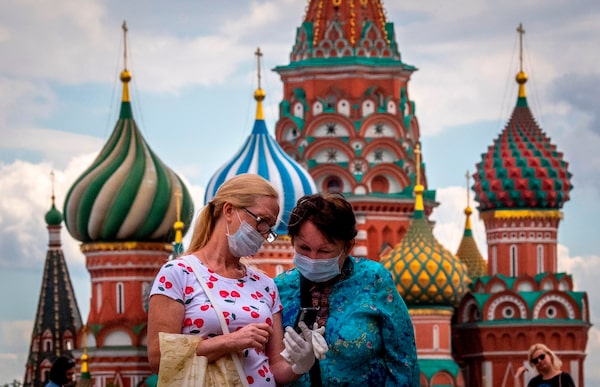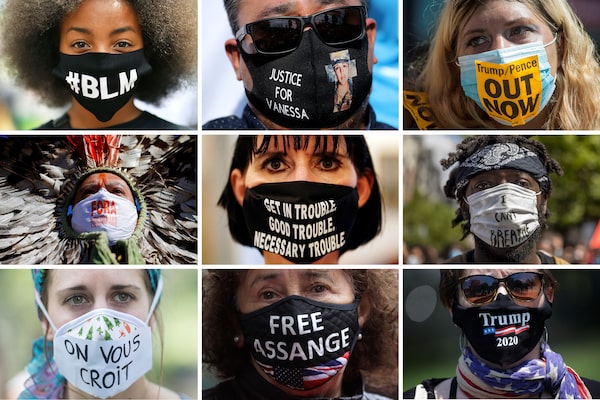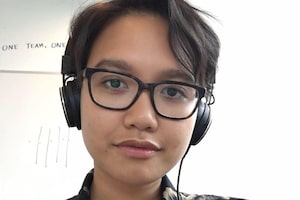
The Associated Press, The Canadian Press, Reuters
When the first cases of COVID-19 emerged in Canada earlier this year, public health authorities put more emphasis on physical distancing than on covering the face. Today though, a growing body of research shows wearing a mask can limit the spread of the disease, and many Canadian provinces and cities – along with a growing list of other countries – are embracing mandatory mask policies and legislation. Here’s a look at mask-wearing around the world and how it’s changed.
Choose a jurisdiction • Canada • U.S. • Brazil • U.K. and Europe • South Africa • India • Russia • Asia-Pacific

Cole Burston/Getty Images/Getty Images
Canada
Toronto was the first city in the country to make masks mandatory in indoor public spaces, on June 30. Quebec, Nova Scotia, and other major cities including Ottawa and Calgary have since enforced similar regulations. New Brunswick, meanwhile, reversed a decision to mandate mask-wearing in public spaces, just one day after announcing the new rule.
While other jurisdictions haven’t mandated mask-wearing, some are calling for it in schools. The Alberta government, for instance, has announced students in Grades 4 to 12 and all staff must wear masks in common areas in September. Only one Canadian municipality has taken the extra step of requiring masks outdoors: Banff, Alta., now requires face coverings along its heavily trafficked commercial strip and in indoor public spaces.
Health officials have urged residents to wear masks in B.C., P.E.I., Saskatchewan, Newfoundland and Labrador and the Northwest Territories, but no regulations have been enforced. In the Yukon, masks are required at airports as of July 1, but they are not mandatory elsewhere.
The new mask-wearing requirements aren’t always welcome. Across the country, “March to Unmask” anti-mask rallies have taken place in Vancouver, Calgary, Saskatchewan, Winnipeg and Ottawa, advocating for freedom of choice in virus protection.
-Hannah Alberga

WIN MCNAMEE/POOL/AFP via Getty Images/AFP/Getty Images
United States
The hardest-hit country in the world, the United States, does not have a federal law requiring mask-wearing in public. While the Centers for Disease Control and Prevention recommend mask-wearing and most Americans say they do so regularly, the practice has also been heavily politicized. In particular, the anti-mask crowd, which leans Republican, says mask-wearing infringes on their liberties. President Donald Trump refused to wear a mask in public, before urging Americans to do so on July 14. As a result, many states have implemented mask-wearing mandates, while others remain resistant to the idea.
On April 8, New Jersey became the first state to require mask-wearing in indoor public spaces. Since then, more than 30 other states have announced state-wide mask-wearing orders with varying scope and enforcement methods. Within the remaining states, most are recommending the practice, while their cities build a patchwork of mask-wearing mandates in lieu of state-wide orders. However, some have faced pushback. In mid-July, Georgia’s Governor Brian Kemp voided mandates already adopted by cities in his state and banned them from adopting future requirements.
The United States has had more than 4.82 million COVID-19 cases and close to 159,000 deaths as of August 5, with the pandemic disproportionately affecting Black and Latino communities.
-Alex Nguyen
Adriano Machado/Reuters/Reuters
Brazil
The second hardest hit country in the world, Brazil has required mask-wearing in public since July 3.
However, President Jair Bolsonaro – who has long downplayed COVID-19 risks and mocked mask-wearing – vetoed the requirement in schools, business, factories and churches. He also vetoed the mandate for businesses to provide masks to employees and for the government to provide masks to “economically vulnerable people.”
Meanwhile, some cities and states have made masks mandatory in public long before this federal law. A mask-wearing law took effect in Rio de Janeiro on April 23, and a mask was projected onto the city’s iconic Christ the Redeemer statue to promote the practice. The federal district, which includes the capital Brasilia, began requiring mask-wearing in public on April 30, subsequently reinforced with a 2,000 reais (around $500 CAD) fine a day for violators.
Brazil has around 2.86 million cases and over 97,000 deaths as of Aug. 5, with Indigenous communities being particularly under threat. Mr. Bolsonaro himself tested positive for COVID-19 on July 7, but reported a negative result on July 25.
More broadly, the uptick in cases from Brazil – along with those from Mexico, Peru, Colombia and Argentina – has made Latin America one of the hardest hit regions in the world.
-Alex Nguyen
Toby Melville/Reuters/Reuters
United Kingdom and Europe
On July 24, Britain joined much of Europe in making face coverings mandatory in shops and most other indoor spaces, but the move came with plenty of confusion and controversy.
It wasn’t clear at first exactly where masks had to be worn – they remained optional in cinemas, hairdressers and other venues. The government tightened the measures on Aug. 8 to include all enclosed public places but most retailers have said they won’t enforce the requirement. That leaves police to hand out tickets, which carry a maximum £100 fine, although officers have said they have better things to do.
Scotland planned to introduce similar rules on Aug. 8, followed by Northern Ireland on Aug. 10. However the Welsh government has said the widespread use of masks was “not supported by high quality scientific evidence.” For now, Wales only requires that face coverings are worn on all public transport.
The same patchwork of rules exists across the rest of Europe. In countries like Italy, Germany, Greece and Spain, masks have been compulsory in shops and most other indoor spaces for weeks. Spain and Germany also require face masks to be worn in most schools. Several countries, including France, Austria and Croatia, have toughened rules about coverings in the wake of a recent surge of infections and they now require face masks in nearly all public places. Switzerland has also moved recently to make face coverings required on all public transport.
Other governments have taken a more relaxed approach. Sweden has few restrictions on anything to do with the pandemic and face masks aren’t compulsory. The same is true in Norway, Denmark, Iceland and Finland, where face coverings aren’t even mandatory on trains or subways, although they have been recommended recently as the number of cases increased. The Czech Republic has also begun to ease some of its strict face mask requirements although coverings are still mandatory on the Prague subway and in some regions.
-Paul Waldie

MARCO LONGARI/AFP via Getty Images/AFP/Getty Images
South Africa
South African President Cyril Ramaphosa struggled awkwardly when he tried to don a face mask at the end of a televised speech to the nation in April. For a moment, the mask covered only his eyes.
But while the television audience laughed, the lesson has largely worked. For months, South African political leaders have consistently worn masks in public, sending a clear message for their citizens.
Compared to countries such as Britain, most South Africans have accepted the need for face masks at a relatively early stage in the pandemic. And unlike other countries such as the United States, there is no active anti-mask movement in South Africa, aside from a tiny minority of conspiracy-minded people on social media.
Stores and malls have set clear rules on mask-wearing, and the rules have been largely accepted. At a national level, masks were made mandatory in public in early May, and by July it became a criminal offence for a business or transport owner to fail to enforce the rule.
Still, surveys have found that many South Africans don’t wear masks consistently, especially in poorer communities. One possible factor: a lack of running water to wash their masks regularly.
-Geoffrey York

Channi Anand/The Associated Press/The Associated Press
India
India has also been hit hard by COVID-19, with 1,385,522 cases as of July 26, placing it third behind Brazil. Much like the United States and Canada, India’s mask policies were at first up to each state to implement for themselves. Uttar Pradesh, India’s most populous state, was among the earliest to impose a mandatory mask policy on April 8. The policy was accompanied with warnings that non-compliance could result in legal action. The first few weeks of April saw a steady wave of mandatory mask policies in several Indian states, some with enforcement measures and some without.
The piecemeal approach to masks was ended on April 15 when the Ministry of Home Affairs issued a directive making masks mandatory across all of India. In the directive, face coverings were now required in all public places and workplaces, though there was no mention of enforcement measures.
An Ipsos 15-Nation survey released on April 21 found that 76 per cent of urban Indians use masks to protect themselves from the virus. Despite the relatively earlier adoption of a nation-wide mask policy, COVID-19 cases in India have soared as the country began to ease its lockdown.
-Josie Kao

YURI KADOBNOV/AFP via Getty Images/AFP/Getty Images
Russia
Russia announced its first cases of COVID-19 on Jan. 31. Since then, the country has reported 812,485 cases and 13,269 deaths (as of July 25, according to the WHO), making it the country with the fourth highest case rate in the world, and the 11th highest mortality rate.
Municipalities have overseen regulations regarding masks. In Moscow, the worst-hit region, mask and glove-wearing in public spaces has been mandatory since May 12, and according to the Mayor will remain so until a COVID-19 vaccine becomes available. St. Petersburg also requires mask and glove-wearing in public spaces.
Human Rights Watch reported in June that medical workers in Russia have been unable to obtain proper PPE and respirators, and some have resigned due to unsafe working conditions. Medical professionals have also alleged that Russia’s official infection count has been altered to downplay the spread and mortality count of the virus. Some health professionals have taken to alternative, subtle forms of dissent, by creating websites to memorialize co-workers lost to the virus, whose deaths were not officially attributed to coronavirus.
-Claire Porter Robbins
Kham/Reuters/Reuters
Asia-Pacific
Across much of Asia, and particularly East Asia, mask-wearing has been the norm for years. Unlike in Western countries where mask usage is low, Asian countries such as Vietnam, China and Singapore have a high degree of compliance.
Vietnam, which has been one of the most successful countries in containing COVID-19, implemented a mandatory mask policy on March 15 along with hefty fines for those who do not comply. The April 21 Ipsos poll found that 91 per cent of Vietnamese people wore masks. Until July 25, the country had reported no COVID-19 cases for three months and no deaths at all, though a small outbreak has since put the country back on high alert.
In Singapore, masks were made compulsory on April 14, along with fines for people who did not comply, though the country has not been as successful as Vietnam in containing the virus. As of July 26, Singapore had reported 49,888 cases and 27 deaths, with migrant workers being among the hardest hit.
In China, the original epicentre of the outbreak, mask usage is very common and the government has not imposed a central mask policy. Instead, some cities, like Beijing and Shanghai, made masks mandatory within their own jurisdictions. On July 27, Hong Kong announced that it would be expanding its mandatory mask policy to include all public spaces, not just indoor public spaces. The expanded policy comes as Hong Kong begins to see a resurgence of the virus.
-Josie Kao

AFP/Getty Images, The Associated Press, The Canadian Press, Reuters
In depth
The mask is the (political) message
Protests against mask-wearing have taken place in many municipalities in North America, demonstrating the divisiveness and politicization of the issue. In Windermere, Florida, a state with one of the highest infection rates in the country, one restaurant risked closure by giving out free grilled cheese sandwiches to patrons who likewise refused to comply with the municipality’s mandatory mask laws.
Most protesters’ reasons for non-compliance typically derive from a sense that government should not interfere with an individual’s choice to wear, or not wear, a mask.
In the U.S., mask support is generally split down party lines. According to polling done by the Pew Research Centre, while most Americans generally support mask-wearing in some situations, “Democrats and Democratic-leaning independents are about twice as likely as Republicans and Republican-leaners to say that masks should be worn always (63% vs. 29%). Republicans are much more likely than Democrats to say that masks should rarely or never be worn (23% vs. 4%).”
Canadians broadly support mask wearing, according to a poll of 1,500 Canadians by Abacus Data. In terms of the relationship between politics and mask wearing, the results are less divisive than in the United States, with the report indicating that Conservative voters are about 9 to 10 percentage points more likely than Liberals and New Democrats to say they never wear a mask.
For those choosing to wear a mask, commercial options now abound, after shortages in North America in early spring. Local crafters have begun selling masks on platforms like Etsy, while larger luxury brands have designer fashion masks.
In a moment of heated protests around the world, masks also provide an opportunity to draw attention to a political or social cause.
In London, protesters have been spotted wearing masks emblazoned with “Free Assange,” while in Toronto, Raptors head coach Nick Nurse and guard Fred VanVleet wore “Black Lives Matter” masks to a press conference, after Nurse gave the masks, made by a Toronto artist, to the team. Staff at retailers like Whole Foods and Starbucks in the U.S. have complained that their employers won’t allow them to wear masks with political or social justice messages, and have launched legal cases against such restrictions.
In an election year, even American political campaigns have jumped on the branding opportunity masks provide. The Trump campaign has distributed red neoprene “Trump 2020″ masks to campaign employees and volunteers, though they are not currently available for purchase. The Biden campaign sells $20 masks labelled with “Biden,” and distributes one unlabeled mask to charity for each Biden mask sold.
-Claire Porter Robbins
Our Morning Update and Evening Update newsletters are written by Globe editors, giving you a concise summary of the day’s most important headlines. Sign up today.
 Hannah Alberga
Hannah Alberga Alex Nguyen
Alex Nguyen Paul Waldie
Paul Waldie Geoffrey York
Geoffrey York